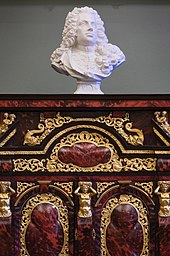Tortoiseshellortortoise shellis a material produced from the shells of the larger species oftortoiseandturtle,mainly thehawksbill sea turtle,which is acritically endangeredspecies according to theIUCNRed List largely because of its exploitation for this trade. The large size, fine color, and unusual form of the hawksbill'sscutesmake it especially suitable. The distinctive patterning is referred to in names such as thetortoiseshell cat,severalbreeds of guinea pig,and the common names of several species of the butterfly generaNymphalisandAglais,and some other uses.



Uses
editTortoiseshell was widely used from ancient times in the North and in Asia, until the trade was banned in 2014. It was used, normally in thin slices or pieces, in the manufacture of a wide variety of items such ascombs,small boxes and frames, inlays in furniture (known asBoulle workcarried out byAndré-Charles Boulle), and other items: frames for spectacles,guitar picksandknitting needles.Despite being expensive, tortoiseshell was attractive to manufacturers and consumers because of its beautiful mottled appearance, its durability, and its organic warmth against the skin.[1]
The initial processing involved separating the layers of the scutes from the animal'scarapaceby heating, softening the plates by boiling them in salt water and flattening them under a press. Two pieces could be fused by use of a hot iron, but like the earlier stages, great care had to be taken not to lose the color. Finishing and polishing was done by various techniques mainly in Europe or in the US.[2][3]Craftsmen in various Asian countries have also perfected this art.
Availability
editIn 1973, the trade of tortoiseshell worldwide was banned underCITES(the Convention on International Trade in Endangered Species).[4]The material was already often imitated in stainedhorn,[5]plasticlikecellulose acetate,[6]and other materials. The syntheticDelrinhas been used especially for guitar picks.[7]
Brandsof synthetic substitutes for tortoiseshell includeTortoloidandTor-tis.
History
editTortoiseshell has been used since ancient times, and the ancient Greekchelysorlyreoften used a whole shell to form its body. Inlaidveneersof tortoiseshell were popular with wealthy ancient Romans for furniture, especially couches for dining, and for small items.[8]ThePeriplus of the Erythraean Sea,probably a work of the 1st century AD, distinguishes between shell from different species, with the best regarded as the hawksbill.[9]
André Charles Boulle(1642–1732),cabinetmakertoLouis XIV of Franceintroduced or perfectedmarquetrycombining thin inlays of tortoiseshell backed with metal, with woods and metal, a style still called after him (Boulle work). Small luxury objects such assnuff-boxeswere decorated inpiqué work,inlays of precious metals and jewels into tortoiseshell (or other materials).[10]
Hopes of capturing a large store of tortoiseshell led to theNgatik massacreby Australian "beachcombers" of up to 50 men ofSapwuahfikinMicronesiain July 1837.
Notes
edit- ^Gary Strieker (10 April 2001)."Tortoiseshell ban threatens Japanese tradition".Archived fromthe originalon 2006-12-15.Retrieved2023-02-24.
- ^Transactions, 344-346
- ^Lupano, Guglielmo; Peola, Paolo (1915).Corso di Scienze Naturali a uso delle Scuole Complementari[A Course of Natural Sciences for the Complementary Institutes] (in Italian). G.B. Paravia. p. 71.
- ^Multi-lateral agreements for conservation of hawksbill turtlesArchived2004-01-10 at theWayback Machine,CITES website
- ^Transactions, 341, 345
- ^Lim, XiaoZhi (28 August 2018)."These Cultural Treasures Are Made of Plastic. Now They're Falling Apart".New York Times.New York Times.Retrieved28 August2018.
- ^"Tortoiseshell picks. Feature article. Reworked".Guitarbench. 2008-10-03. Archived fromthe originalon 2010-12-26.Retrieved2012-07-30.
- ^Transactions, 344
- ^Casson, 205
- ^"pique work (metalwork) - Britannica Online Encyclopedia".Britannica.Retrieved2012-07-30.
References
edit- Casson, Lionel, "Periplus Maris Erythraei: Notes on the Text",The Journal of Hellenic Studies,Vol. 102, (1982), pp. 204–206,JSTOR
- Caunes, Lison de, and Jacques Morabito. 1997. L’écaille [Tortoiseshell]. Dourdan: Vial.ISBN2851010476
- "Transactions", "On Horn and Tortoiseshell",Transactions of the Society, Instituted at London, for the Encouragement of Arts, Manufactures, and Commerce,Vol. 52, PART II (1838–1876), pp. 334–349,Royal Society for the Encouragement of Arts, Manufactures and Commerce,JSTOR